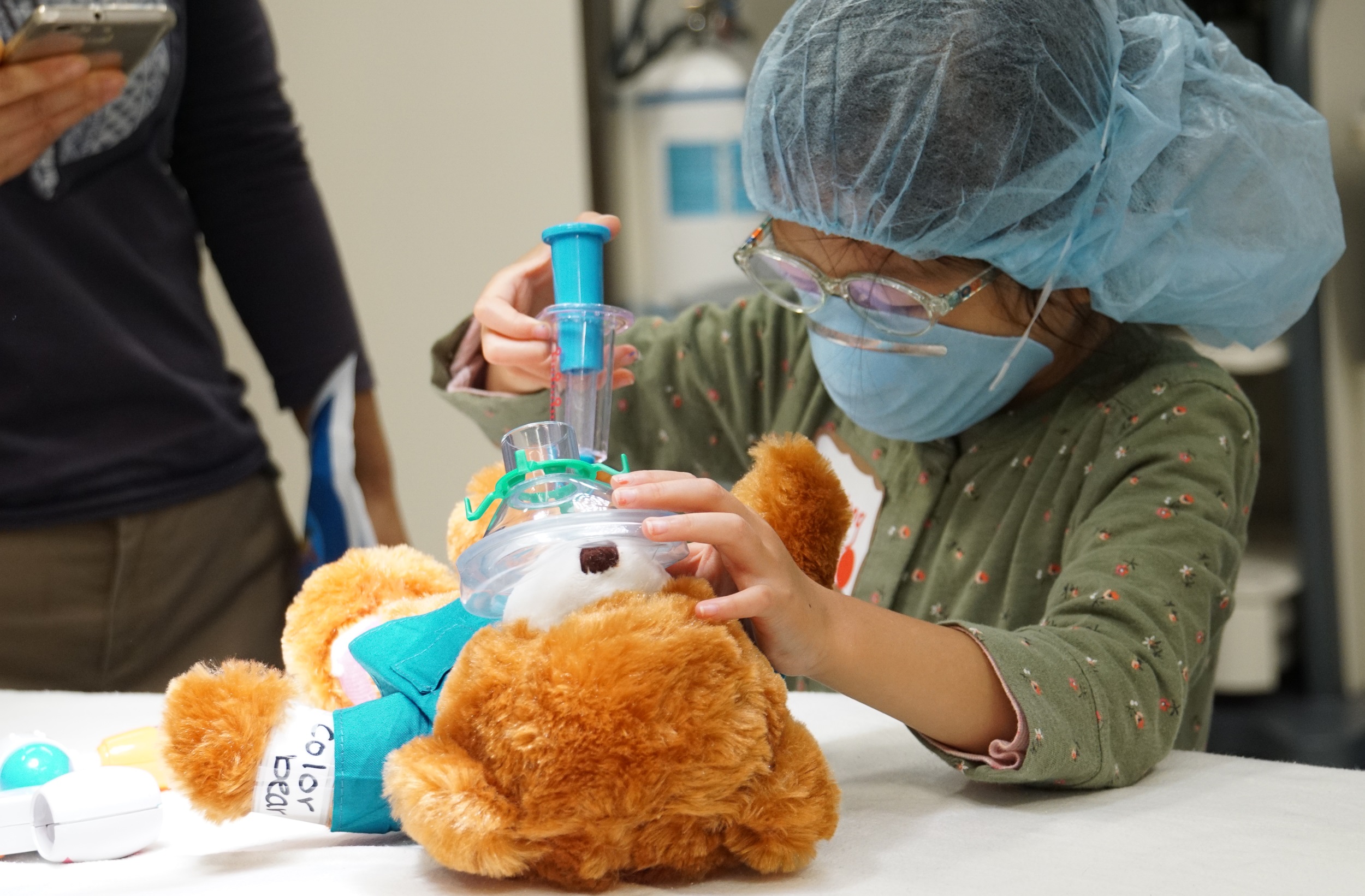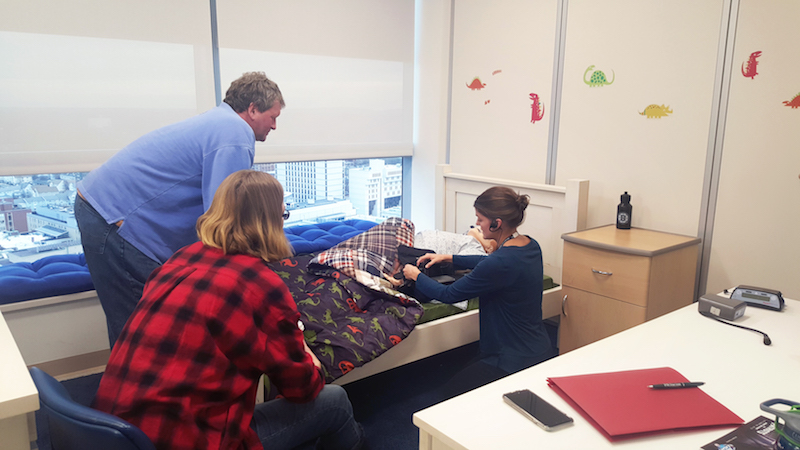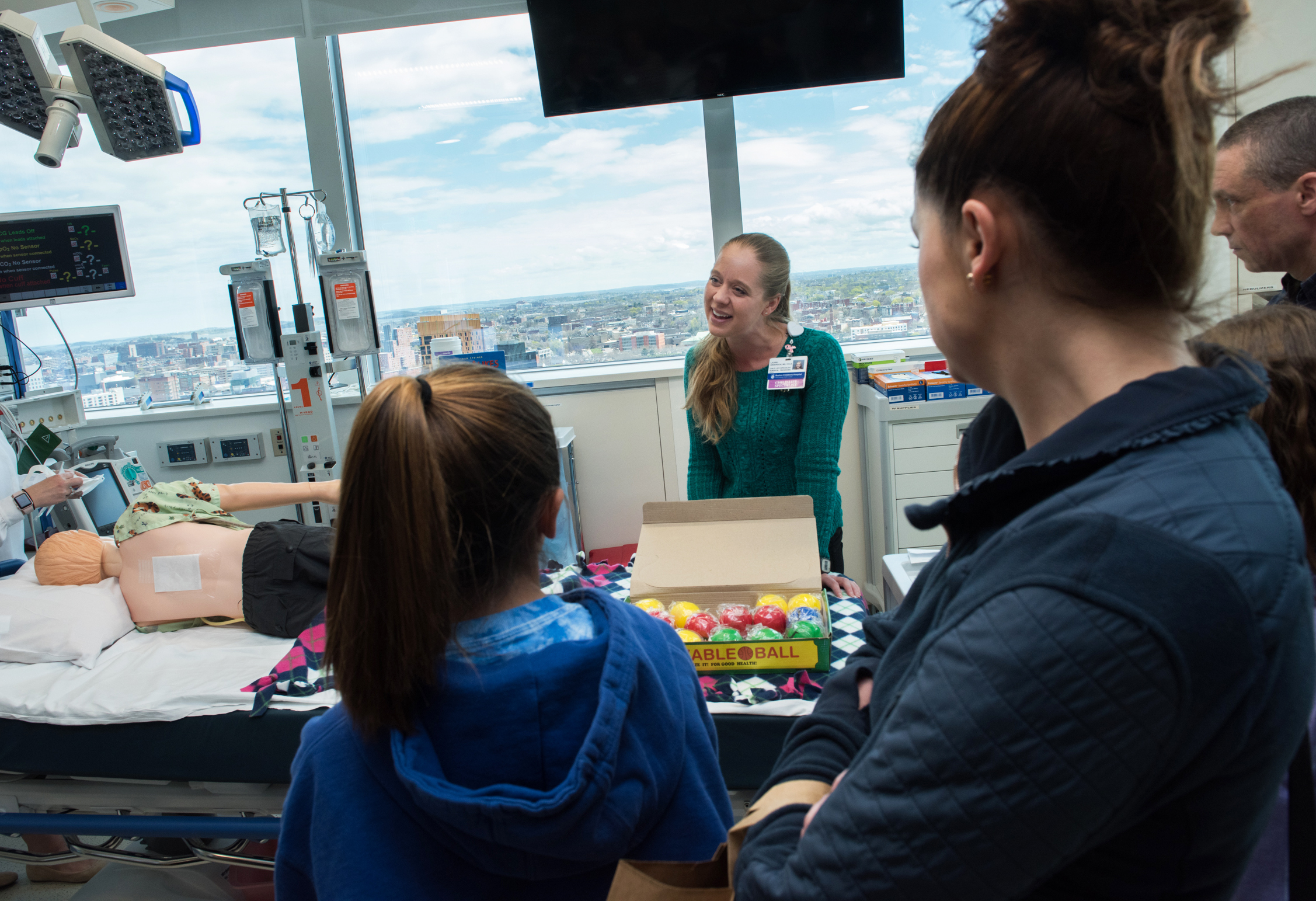
Getty Images/iStockphoto
Improving Pediatric Patient Experiences with Age-Appropriate Education
At Boston Children’s Hospital and Children’s Hospital of Philadelphia, reducing patient fears and improving pediatric patient experiences is child’s play.

For pediatric patients and their parent caregivers, fear in a hospital is a normal thing. Young patients can experience sensory overload, parent and child are often separated during procedures, and there is the looming fear of an adverse health event.
High anxiety can be detrimental to the pediatric patient experience, but many children’s hospitals are taking creative and effective approaches to reducing stress and improving outcomes by engaging patients in medical simulations and age-appropriate education.
For pediatric patients, the perceived threats of medical care can trigger fear and anxiety, which in turn can get in the way of effective medical care.
The concerns that patients harbor usually vary depending on the child’s developmental stage, according to the Phoenix Children’s Hospital.
Preschool aged children and toddlers usually experience separation anxiety and concerns about unfamiliar medical equipment, while school-aged children tend to fear a loss of control, the possibility of pain, and even a fear of death following a serious illness or procedure.
Teens fear separation from their peer group and a disruption in their social connections, a change in body image, or loss of control, privacy, and independence.
Medical simulations and demonstrations have proven effective for combating these concerns because they are concrete and engaging, said Brianna O’Connell, MS, CCLS, a child life specialist and program lead with the Simulator Program (SIMPeds) at Boston Children’s Hospital.
“Psychologically, we know that the ability for kids to put their hands on equipment and have control over it causes desensitization,” O’Connell explained. “It also helps creates developmental mastery and control over those items and makes patients less likely to have high levels of anxiety and more likely to be successful when they come in for a procedure.”
Successful medical simulations and demonstrations require coordinated teamwork and a commitment to developmentally appropriate materials and language.
Medical play, simulation to prepare for the hospital
When a child is admitted to the hospital, healthcare organizations focus on normalizing that event. They create opportunities for children to socialize and continue daily routines.
These efforts not only create more pediatric patient satisfaction, but also help familiarize and desensitize patients to their new medical environment. These efforts can start out small, with something as simple as a doctor play set that serves to empower a patient during an eventual care encounter.
“We do a lot of teaching through medical play, and this can be done at very early ages,” said Beth Donegan Driscoll, MS, CCLS, Director of Child Life Services at Boston Children’s.
“We take out a doctor's kit and expose the child to a play doctor's kit. This helps the child to understand what it's being used for and why it's being used.”
Boston Children’s also allows patients to experience a certain procedure without quite undergoing the full therapy.
Under O’Connell’s guidance, child life specialists, clinicians, and other healthcare professionals have worked with SIMPeds to develop its “Preparing You” program to address the concerns many children have when going to the hospital.
Preparing You creates opportunities for patients, parents, and caregivers to learn more about a child’s health and how aspects of treatment will fit together. All of this is done in a manner that is suitable for an individual’s developmental needs, O’Connell noted.
For example, patients with autism often have high rates of seizures, which means they must undergo regular EEGs, O’Connell said. These patients, who typically have sensory sensitivity, frequently experience high anxiety before a procedure.
“We have the ability to simulate that entire experience for them in our simulation space,” O’Connell said. “Patients can come here and have repeated exposures for desensitization so ideally they'll be more successful when it comes to actually having their EEG.”
Boston Children’s also hosts module-based simulations, or stations where patients can learn about the different steps of the healthcare process. A patient scheduled for a surgery can come in with her family and look at the entire perioperative process, from pre-op admitting to pre-op holding to getting an IV placed.
“They get to help flush the medications on the IV on a mannequin, for example,” O’Connell noted.
These efforts are targeted at reducing anxiety for the child and family, according to Kate Carpenter, MEd, CCLS III, a child life specialist at the Children’s Hospital of Philadelphia. CHOP has a host of options to help familiarize pediatric patients with certain testing environments.
The hospital has videos, booklets, and a mock MRI machine, among other tools. These props help the patient and her family understand what will happen when she receives an MRI, allows her to practice sitting still, and acquaints her with the sounds in the machine.
“By nature, children have wonderful imaginations, but we know that sometimes their imaginations can get the best of them,” Carpenter pointed out.
“Rather than having them guess about what’s going to happen in the hospital, we have instructional videos and books for patients and families to view prior to coming to the hospital. That way they can know what to expect.”
In turn, these preparation exercises can reduce preventable pain and suffering.
“We hope to reduce patient anxiety because there’s a lot of research out there that says people with higher anxiety report higher pain scores,” Carpenter said.
“Our goal is to try to reduce some of that anxiety by making those potentially painful experiences less anxiety-provoking and then ultimately less painful.”

Using modules as a caregiver education tool
Boston Children’s also hosts hands-on demonstrations and classes with the parent in mind, helping to allay caregiver fears and equip them with the knowledge necessary to care for their child.
“We ended up with a few different platforms that have developed out of Preparing You, and one is targeted at preparing parents and caregivers for taking their child home with new and complex medical equipment and diagnosis,” said O’Connell.
Preparing You might help a parent or caregiver treat a child who leaves the hospital with a tracheotomy or a central line, for example. Parents going home with seriously ill children will soon become responsible for that child’s care and will need adequate preparation.
“These families are going through what for many of them is the worst time of their lives,” O’Connell said.
“We're sending these kids to their homes, and instead of having a set of critical care nurses and doctors at their bedside 24 hours a day, they now have mom and dad,” she added. “That can be scary for both the parents and the patients. All of these factors are things that have to go into how we develop these courses.”
These parent-focused simulations are more efficient in delivering caregiver education than traditional caregiver education booklets, O’Connell said. Caregiver education is essential to achieving better patient outcomes and has been proven to reduce adverse events such as preventable readmissions.
When parents and other caregivers have a hands-on environment in which to learn about their child’s at-home care, they learn more quickly and more completely. Better caregiver education also results in fewer caregivers expressing fear and anxiety after using a training module, O’Connell noted.

Pediatric care is a team sport
Healthcare organizations must leverage several different players to successfully carry out a simulation program. Simulation developers, child life specialists, clinicians, psychologists, and other pediatric experts are all essential team members.
O’Connell frequently partners with clinicians at Boston Children’s to review patient education curricula and identify areas where materials can better serve pediatric populations. The partnership between child life specialists and clinicians ensures that patients receive both the clinical and emotional support they need.
“We partner so that we have child life specialists at each of the module stations,” O’Connell explained.
“You may have a surgeon who's explaining how the spinal fusion surgery works, but there's also a child life specialist there to help interpret the language, keep an eye out for stress signals from the patients and their parents, and help bring up typical things that are helpful for coping.”
If pediatric care is a team sport, parents and caregivers are the team captains.
“Parents know their child better than anyone else in the world, so we want to start a conversation with them,” Donegan Driscoll explained.
Donegan Driscoll always asks parents about their child’s coping mechanisms, or if the child usually has a lot of questions. This will help the child life specialist and the provider to better target their efforts toward full patient and parent engagement.
“We want parents to tell us about their child.From there we can help the family create a plan,” Donegan Driscoll asserted. “We never go in there and say, ‘We think your child should have this at this time and this much information.’ We say, ‘You tell us first, and then together we'll work on a plan.’”
Parental involvement in pediatric care is important, and Donegan Driscoll ensures parents are aware of the value they bring.
Including the parent caregiver in the care team requires not only parent leadership, but strong communication and education on the part of the provider, O’Connell pointed out.
O’Connell says she uses similar techniques communicating with parents as she does children, although her discussions with parents often strike a more mature tone.
“Any time you're working with patients and families, you must individualize interventions to their needs,” O’Connell said. “You must look at how this non-medical learner, this lay person, will best learn information.”
Siblings also have to be a part of this team, according to Carpenter, the child life specialist from CHOP. Siblings might be confused by their brother’s or sister’s diagnosis, scared of the prognosis, or have trouble understanding how they themselves fit into the puzzle.
“I try to do a lot of support for siblings so they understand what is happening to their brother or sister,” Carpenter said. “They need to feel like they have a safe space to ask questions or process information that can be challenging.”
CHOP hosts Sib Shops, a program specifically designed for brothers and sisters of children with chronic illness or developmental issues that require special attention. This provides siblings with a chance to talk about their feelings and to relate to others who are going through similar experiences.
Grounding efforts in developmentally-appropriate communication
At the center of all efforts is the need to make pediatric patient experience developmentally appropriate, each of the experts said.
“In our role as child life specialists, we are the experts when it comes to talking to kids about challenging issues,” Carpenter said.
“Many times, that includes being concrete and trying to stray away from using any sort of abstract language, while also being mindful that many healthcare experiences can be very scary for kids,” she added.
“We want to encourage our staff to be very honest about what is happening, but do so in a way that is a little less scary.”
For example, when a child asks Carpenter if something will hurt, she’ll respond saying “some kids tell me this might feel like a quick pinch,” or, “some kids tell me that fluid feels like it’s warm when it’s going through the IV.”
Those are honest responses, without telling the patient the shot will throb or the fluid will burn.
For an older patient, Carpenter uses more mature, more direct, and more technical language. While she is still ensuring communication is developmentally appropriate, she is also charged with preparing this teen for adult care that is fast approaching.
“Part of my skill set is to be able to assess what patients and families need in the moment, and that requires understanding the developmental spectrum of the kids we do work with,” Carpenter noted.
Clinicians and child life specialists must be sure not to use too much abstract language, Donegan Driscoll added, especially when working with young children who often take things very literally.
Words matter, she said, and choosing the right ones is the difference between a positive, negative, or confusing healthcare experience.
“The preschooler, for example, has magical thinking,” Donegan Driscoll offered as an example. “Unless you explain things in a very concrete way, they can get confused and not understand why things are happening and if they caused something to happen.”
Donegan Driscoll always asks preschool aged children to sit on the “bed on wheels” instead of the stretcher. When a child hears “stretcher,” he hears something to do with stretching the body. A “bed on wheels” is a much better descriptor for her purposes.
“We never use the word ‘shot’ because kids can get very confused about what a shot is,” Donegan Driscoll added. “If someone gets shot in the outside world, it means something very different than if someone says a shot in the hospital, meaning a needle.”
Child life specialists and clinicians must also remember that a patient’s chronological age is not necessarily her developmental age, according to Donegan Driscoll.
“We are trained on how to give explanations to children depending on what stage of development they're at,” she explained. “Our main purpose is to meet the child where they are and to help them journey through the hospital experience.”
This, in turn, will prevent some of the consequences of frequent or prolonged hospitalization, Donegan Driscoll added, be they emotional, psychological, or developmental.
Depending on the length of stay and the severity of disease, these issues can range from regression in childhood skills to social withdrawal and isolation.
“We must ask ourselves, ‘If this child was not in the hospital, what type of skills would they be working on? What would their world look like if they weren't in the hospital?’ We try to bring that world into the hospital for them,” Donegan Driscoll explained.
At Boston Children’s, child life specialists socialize kids in the playroom, or work on developmental milestones such as object permanence or tracking.
Of course, this work can be challenging for providers, as well, said Carpenter. It can be hard to separate professionalism from the compassion needed to do her job.
“Part of being a child life specialist is being able to connect with families during some of their scariest times so that they feel safe and supported,” she noted.
As challenging as it may seem, this is a job that Carpenter says is essential to the medical profession. Healthcare leaders must talk to pediatric patients about their health and prepare them for the procedures ahead – even if those procedures are scary and tough to talk about.
“There’s often a misconception that we shouldn’t tell kids about what we would consider scary things done to them,” Carpenter said. “By telling children about the treatment, we fear we’ll make them worry about it.”
“The truth of the matter is that a lot of times kids pick up on what’s happening around them,” she concluded. “By not telling them about their health, we don’t have a trusting relationship with them and they may not feel as safe as if we were being honest.”







